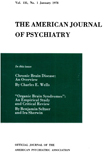PREGNANCY EXPERIENCE AND THE DEVELOPMENT OF BEHAVIOR DISORDER IN CHILDREN
Abstract
The prenatal and paranatal records of children with behavior disorders born in Baltimore after 1939 show significantly more complications of pregnancy and delivery, and prematurity than their matched controls. The non-mechanical abnormalities such as toxemia appear to be the important factors in this association rather than the mechanical factors of delivery. These associations are still present even when intellectual and environmental factors are controlled. Hyperactive, confused, and disorganized children have even more of these abnormalities in their background.
A hypothesis of a continuum of reproductive casualty is formulated consisting of brain damage incurred during these periods leading to a gradient of injury extending from fetal and neonatal death through cerebral palsy, epilepsy, mental deficiency, and behavior disorder. The implications of this continuum are discussed with regard to further research in the etiology, diagnosis, management, and prevention of these neuropsychiatric disorders.
Access content
To read the fulltext, please use one of the options below to sign in or purchase access.- Personal login
- Institutional Login
- Sign in via OpenAthens
- Register for access
-
Please login/register if you wish to pair your device and check access availability.
Not a subscriber?
PsychiatryOnline subscription options offer access to the DSM-5 library, books, journals, CME, and patient resources. This all-in-one virtual library provides psychiatrists and mental health professionals with key resources for diagnosis, treatment, research, and professional development.
Need more help? PsychiatryOnline Customer Service may be reached by emailing [email protected] or by calling 800-368-5777 (in the U.S.) or 703-907-7322 (outside the U.S.).



